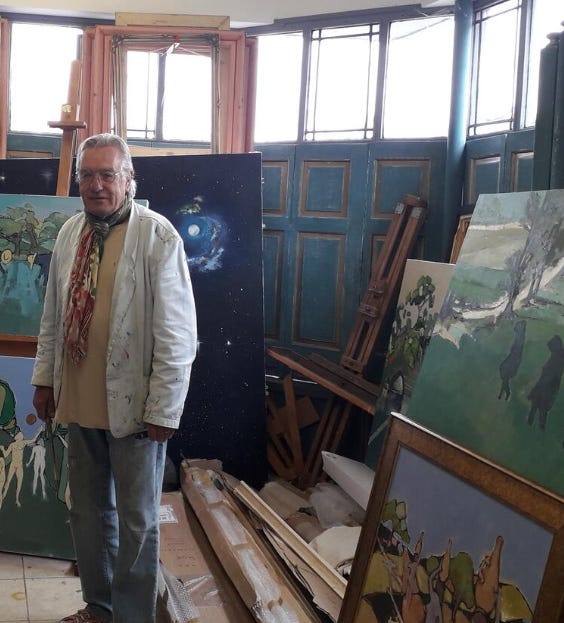‘Art is my way of protesting’
Jack Watto explains to Julia Thorley the evolution of his art and the passion behind his latest exhibition.
Jack Watto has a studio in a beautiful building in Kettering that began life as a coal merchant’s premises, but has seen many incarnations. Now the space is a riot of colour, quirk and elegance, quite a contrast to the clean but equally stylish lines of the upstairs studio of his photographer wife Maura Bright.
Jack paints full time from his studio, where he specialises in oils. He is known for his vivid and emotive figurative and abstract expressionist works.
“You could say abstract art is the hardest of all disciplines,” he says, “because it comes straight out of the mind. I’m fascinated by how it works and find the process of creating enthralling. I work hard to create the interplay between shape, form and colour and become totally absorbed.
“I suppose everything I do is potentially for sale, but that’s not the motivation. You have to be yourself or you stifle your imagination. You find your own creative direction and then stay with it, and my work is an expression of how I look at the world. With realist art, such as portraiture, there’s a degree of finality, but abstract art opens door after door in the mind’s eye. It’s like decorating a room. You might start off with one style, but over time it changes and the process never stops. Nothing is ever finished unless it’s gone out of the door.”
Jack is a Londonder by birth. At 16 years of age, encouraged and supported by his art teacher, Jack was given a place at Camberwell School of Art for two years. He went to study at The Slade School of Art in London, working with Frank Auerbach, mentoring with Howard Hodgkin and studying with Keith Vaughan, whose figurative studies remain an inspiration.
“Mixing with so many and different artists at Camberwell and The Slade caused an explosion in my mind. The eclectic mix was wonderful and I was influenced by everyone; it just crept in. Even though I was studying Fine Art, I had total freedom. The atmosphere was quite casual in many ways, and the mindset of the tutors encouraged us to explore wherever imagination took us. After a Secondary Modern education, I couldn’t get my head around it – calling the tutors by their first names! – but it was like being with friends and it was what I needed.”
After graduation, Jack became an architectural sculptor and restorer and travelled the world working on UNESCO World Heritage sites. Eventually, he returned to the UK to work on heritage projects throughout England and Europe, before settling in Kettering.
“At university, I had a small grant, but there was a pull to work during the holidays. I was drawn to stone and architectural sculpture. I liked its organic, hands-on nature. This was start of a journey that eventually led me to UNESCO. I was a diver and I suppose I became the eyes and ears of the sea. I worked as a volunteer with organisations such as Greenpeace on undercover investigations, often in quite dangerous situations, filming newsfeed or documentary footage for the BBC or ITN.”
This was the beginning of his concern for the planet. He says he always had it in mind to make a difference, and this is reflected in his current exhibition, Art for Planet Earth. Two years in the making, it is a series of large canvases on the subject of the environment and climate emergency, and has enabled him to channel his deep concern for the changes we are all witnessing.
It’s not only an artistic exploration of this subject. The catalogue that accompanies the exhibition, currently at Rooftop Arts in Corby, also includes thought-provoking articles on topics including fossil fuels, the climate emergency, pollution and destruction of the ecosystem, including the crisis in our oceans. There is also information on how to become a ‘planetary lobbyist’.
“Art for Planet Earth is about educating people, especially our young people. I’m planning to tour it to Northamptonshire schools, including Bishop Stopford and Southfield. I’m also looking at taking it into cathedrals, perhaps Canterbury, because it’s relevant to faith groups.”
Jack is a keen observer of the social condition. He is currently working on another big canvas exploring the subject of migration and immigration.
“It’s an issue that has always existed, but it’s relevant now because our planet is overcrowded. I want to give the narrative to the ‘strangers’, with everyone else as the viewer. Art is my way of protesting. I protest with a wet brush, as writers and poets do with their pens.”
Art for Planet Earth is at Rooftop Arts until 5th October. Jack can be contacted through his website



